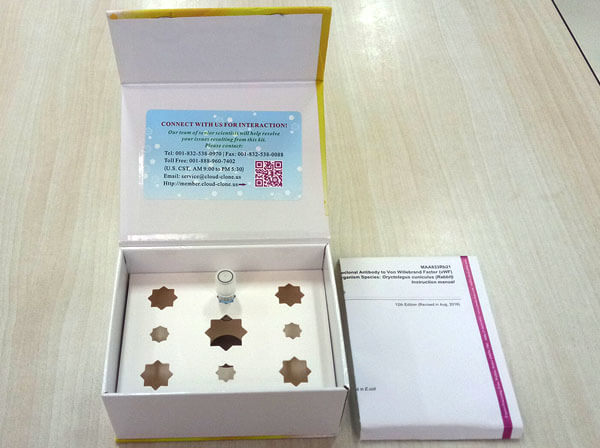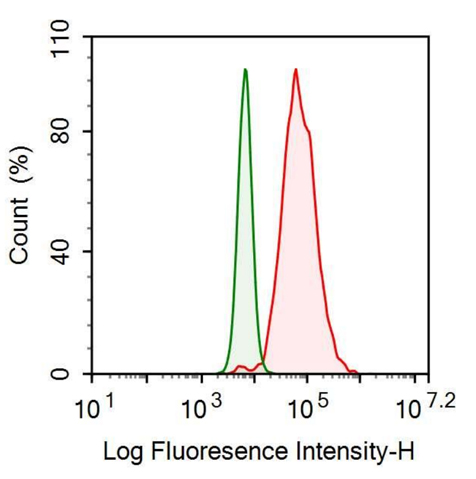抗可溶性半乳糖凝集素3结合蛋白(LGALS3BP)单克隆抗体
Anti-Lectin Galactoside Binding, Soluble 3 Binding Protein (LGALS3BP) Monoclonal Antibody
MAC-2-BP; LGALS3-BP; Galectin-3-Binding Protein; L3 Antigen; Mac-2-Binding Protein; Tumor-associated antigen 90K; Serum Protein 90K; Basement membrane autoantigen p105
用法
Flow cytometry: 10µg/ml;
Optimal working dilutions must be determined by end user.
储存
经常使用则4°C保存。-20°C保存不超过一年。避免反复冻融。
赠品
增值服务
相关产品
| 编号 | 适用物种:Homo sapiens (Human,人) | 应用(仅供研究使用,不用于临床诊断!) |
| RPB766Hu01 | 可溶性半乳糖凝集素3结合蛋白(LGALS3BP)重组蛋白 | Positive Control; Immunogen; SDS-PAGE; WB. |
| PAB766Hu01 | 可溶性半乳糖凝集素3结合蛋白(LGALS3BP)多克隆抗体 | WB; IHC; ICC; IP. |
| MAB766Hu22 | 可溶性半乳糖凝集素3结合蛋白(LGALS3BP)单克隆抗体 | WB; IHC |
| MAB766Hu21 | 可溶性半乳糖凝集素3结合蛋白(LGALS3BP)单克隆抗体 | WB; IHC |
| FAB766Hu02 | 抗可溶性半乳糖凝集素3结合蛋白(LGALS3BP)单克隆抗体 | Flow cytometry. |
| FAB766Hu04 | 抗可溶性半乳糖凝集素3结合蛋白(LGALS3BP)单克隆抗体 | Flow cytometry. |
| FAB766Hu06 | 抗可溶性半乳糖凝集素3结合蛋白(LGALS3BP)单克隆抗体 | Flow cytometry. |
| FAB766Hu08 | 抗可溶性半乳糖凝集素3结合蛋白(LGALS3BP)单克隆抗体 | Flow cytometry. |
| LAB766Hu72 | 可溶性半乳糖凝集素3结合蛋白(LGALS3BP)单克隆抗体(生物素标记) | WB; IHC; ICC. |
| SEB766Hu | 可溶性半乳糖凝集素3结合蛋白(LGALS3BP)检测试剂盒(酶联免疫吸附试验法) | Enzyme-linked immunosorbent assay for Antigen Detection. |
| LMB766Hu | 可溶性半乳糖凝集素3结合蛋白(LGALS3BP)等多因子检测试剂盒(流式荧光发光法) | FLIA Kit for Antigen Detection. |
| PSB766Hu01 | 可溶性半乳糖凝集素3结合蛋白(LGALS3BP)抗体对 | ELISA; CLIA; ELISPOT; Luminex; Immunochromatography and other Immunoassays. |
| KSB766Hu01 | 可溶性半乳糖凝集素3结合蛋白(LGALS3BP)检测试剂盒DIY材料(酶联免疫吸附试验法) | Main materials for "Do It (ELISA Kit) Yourself". |
参考文献
| 杂志 | 参考文献 |
| Andrology | Comparative proteomic analysis coupled with conventional protein assay as a strategy to identify predictors of successful testicular sperm extraction in patients with non-obstructive azoospermia[PubMed: 23427166] |
| Liver International | Identification of candidate biomarkers for hepatocellular carcinoma in plasma of HCV-infected cirrhotic patients by 4-D DIGE[Pubmed: 23944848] |
| Acta Anaesthesiologica Scandinavica | Early prognostic factors in septic shock cancer patients: a prospective study with a proteomic approach[Pubmed:29315472] |



